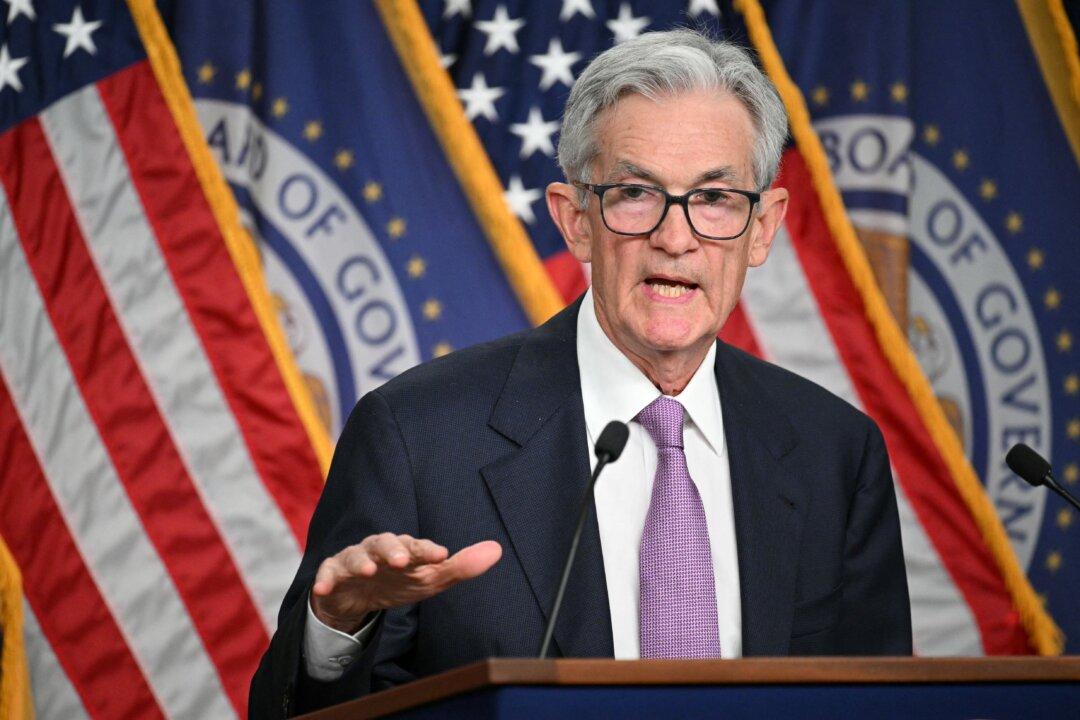U.S. stocks ended the Sept. 20 session mixed but registered notable gains for the week, fueled by the Federal Reserve initiating the easing cycle with a significant interest rate cut.
The blue-chip Dow Jones Industrial Average picked up 38.17 points, or 0.09 percent, to close the Sept. 20 trading session at 42,063.36, a new all-time high. The 30-stock index posted a weekly boost of 1.62 percent, lifting its year-to-date gain to nearly 12 percent.
The tech-heavy Nasdaq Composite Index slipped 65.66 points, or 0.36 percent, to 17,948.32. The Nasdaq enjoyed a weekly gain of 1.49 percent and has rallied close to 20 percent this year.
The S&P 500 dipped 11.09 points, or 0.19 percent, to 5,702.55. It posted a weekly jump of 1.36 percent and has climbed about 20 percent in 2024.
Stocks reacted favorably to the Fed cutting interest rates for the first time since March 2022.
Nikhil Choraria, the head of European Flow Rates Trading at Goldman Sachs, wrote in a note to clients that the Fed’s strong start right out of the gate “is a clear statement of intent that the Fed does not want to be behind the curve.”
As economic observers debate the rationale for a 50-basis-point rate cut, the markets liked it, said Jamie Cox, the managing partner for Harris Financial Group.
“Markets like rate cuts, especially big ones when the economy is strong,” Cox said in a note. “The Federal Reserve made its presence known in protecting the labor market before it weakens further.”
Indeed, Powell stated that the monetary authorities will concentrate on the other side of its dual mandate: Maximum employment.
“You now have a cooler labor market, in part because of our activity. So, what that tells you is it’s time to change our stance. So we did that,” Powell told reporters. “The sense of the change in the stance is that we’re recalibrating our policy over time to a stance that will be more neutral.”
While the decision overwhelmingly favored a 50-basis-point cut, Fed Gov. Michelle Bowman was the lone dissenter. She wanted to start the cycle with a modest quarter-point rate cut.
Constellation Energy, FedEx Capture Attention
Nuclear energy operator Constellation Energy was a big winner to close out the trading week after the company announced a new agreement with Microsoft.The company plans to reopen the Three Mile Island facility in Pennsylvania as the tech titan plans to buy 20 years’ worth of power from Constellation beginning in 2028. The Nuclear Regulatory Commission must still review and approve the decision before the plant reactor can be restarted.
In 1979, the Three Mile Island facility experienced a partial nuclear meltdown on its Unit 2 reactor, suffering the worst accident in the nation’s history of commercial nuclear generation. The plant shuttered its Unit 1 reactor in 2019 due to declining revenues. The agreement with Microsoft is to restore Unit 1.
“Before it was prematurely shuttered due to poor economics, this plant was among the safest and most reliable nuclear plants on the grid, and we look forward to bringing it back with a new name and a renewed mission to serve as an economic engine for Pennsylvania,” said Constellation CEO Joe Dominguez in a statement.
Constellation shares surged more than 22 percent to end the day just below $255.

The transportation stock slumped more than 15 percent, sliding below $255, after the company reported first-quarter earnings of $3.6 per share on $21.58 billion in revenues. The consensus estimate was $4.76 in earnings per share on $21.93 billion in revenues.
Gold Glitters
Gold broke past the $2,600 barrier and registered a fresh record high.The yellow metal added to its gains on the Fed policy shift.
Gold typically benefits in a falling-rate economic climate because it diminishes the opportunity cost of holding non-yielding bullion.
Weakness in the U.S. dollar and dollar-related assets further supported the precious metal.
A lower buck is usually positive for gold prices because it makes it cheaper for foreign investors to purchase.
ING recently adjusted its gold forecast for 2025, projecting an average price of $2,700 an ounce.
Ewa Manthey, the bank’s commodities strategist, cited the Fed’s long-awaited rate cut, the November election, geopolitical tensions, and central bank demand as factors for gold’s rise.







